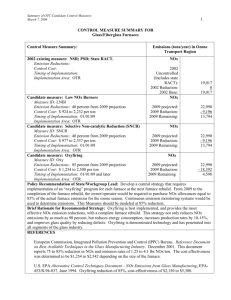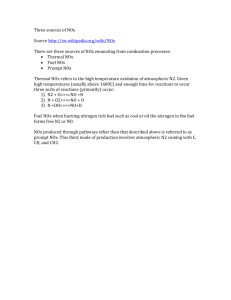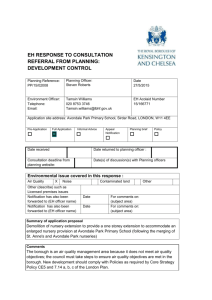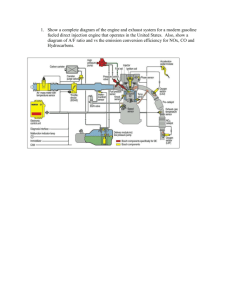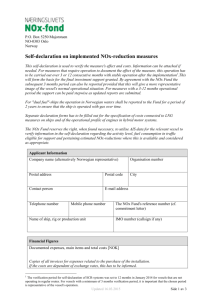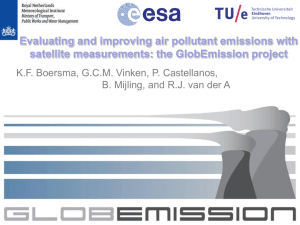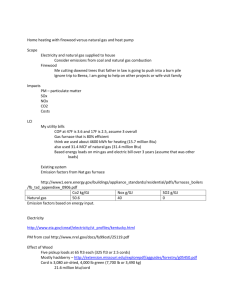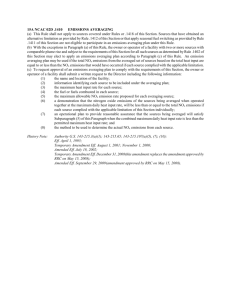OTC White Paper NOx Controls for Natural Gas Pipeline
advertisement
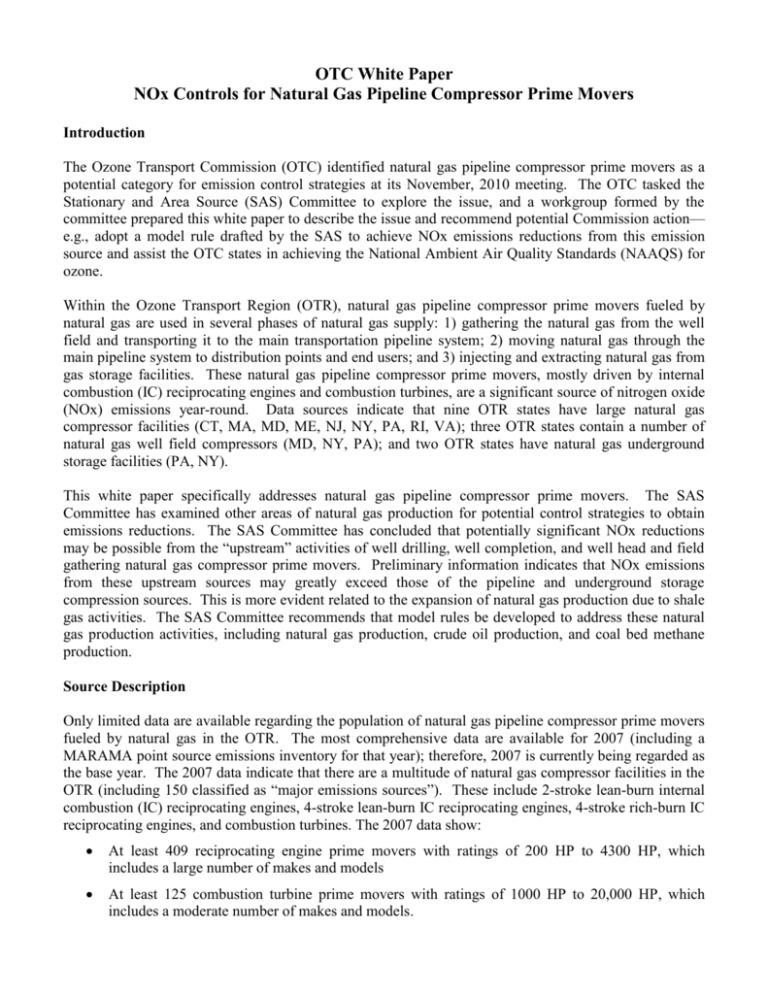
OTC White Paper NOx Controls for Natural Gas Pipeline Compressor Prime Movers Introduction The Ozone Transport Commission (OTC) identified natural gas pipeline compressor prime movers as a potential category for emission control strategies at its November, 2010 meeting. The OTC tasked the Stationary and Area Source (SAS) Committee to explore the issue, and a workgroup formed by the committee prepared this white paper to describe the issue and recommend potential Commission action— e.g., adopt a model rule drafted by the SAS to achieve NOx emissions reductions from this emission source and assist the OTC states in achieving the National Ambient Air Quality Standards (NAAQS) for ozone. Within the Ozone Transport Region (OTR), natural gas pipeline compressor prime movers fueled by natural gas are used in several phases of natural gas supply: 1) gathering the natural gas from the well field and transporting it to the main transportation pipeline system; 2) moving natural gas through the main pipeline system to distribution points and end users; and 3) injecting and extracting natural gas from gas storage facilities. These natural gas pipeline compressor prime movers, mostly driven by internal combustion (IC) reciprocating engines and combustion turbines, are a significant source of nitrogen oxide (NOx) emissions year-round. Data sources indicate that nine OTR states have large natural gas compressor facilities (CT, MA, MD, ME, NJ, NY, PA, RI, VA); three OTR states contain a number of natural gas well field compressors (MD, NY, PA); and two OTR states have natural gas underground storage facilities (PA, NY). This white paper specifically addresses natural gas pipeline compressor prime movers. The SAS Committee has examined other areas of natural gas production for potential control strategies to obtain emissions reductions. The SAS Committee has concluded that potentially significant NOx reductions may be possible from the “upstream” activities of well drilling, well completion, and well head and field gathering natural gas compressor prime movers. Preliminary information indicates that NOx emissions from these upstream sources may greatly exceed those of the pipeline and underground storage compression sources. This is more evident related to the expansion of natural gas production due to shale gas activities. The SAS Committee recommends that model rules be developed to address these natural gas production activities, including natural gas production, crude oil production, and coal bed methane production. Source Description Only limited data are available regarding the population of natural gas pipeline compressor prime movers fueled by natural gas in the OTR. The most comprehensive data are available for 2007 (including a MARAMA point source emissions inventory for that year); therefore, 2007 is currently being regarded as the base year. The 2007 data indicate that there are a multitude of natural gas compressor facilities in the OTR (including 150 classified as “major emissions sources”). These include 2-stroke lean-burn internal combustion (IC) reciprocating engines, 4-stroke lean-burn IC reciprocating engines, 4-stroke rich-burn IC reciprocating engines, and combustion turbines. The 2007 data show: At least 409 reciprocating engine prime movers with ratings of 200 HP to 4300 HP, which includes a large number of makes and models At least 125 combustion turbine prime movers with ratings of 1000 HP to 20,000 HP, which includes a moderate number of makes and models. Many of these prime movers may be in excess of 40 years old. The MARAMA point source emissions inventory data indicates that in 2007 this population of natural gas prime movers emitted approximately 11,000 tons of NOx in the OTR annually (about 30 tons/day on average). Regulatory History Many of the OTR natural gas pipeline compressor prime movers were subject to review and potential regulation under applicable state NOx Reasonably Available Control Technology (RACT) provisions. The stringency of these regulations varies from state to state. Subsequent to the initiation of NOx RACT regulatory activities in the 1990’s, the operating characteristics of these compressors may have changed, and there has been progress in the effectiveness of retrofit NOx controls for many of the types of natural gas pipeline compressor prime movers in the OTR. Some states may also have addressed NOx emissions from these prime movers as part of updated NOx RACT or pollution transport regulations. Two examples are as follows: State New York Rule/Regulation New York State Department of Environmental Conservation, Subpart 227-2, Reasonably Available Control Technology (RACT) For Major Facilities of Oxides Of Nitrogen (NOx) Pennsylvania Chapter 145. Interstate Pollution Transport Reduction, Subchapter B. Emissions of NOx From Stationary Internal Combustion Engines NOx Limits Comments Stationary Gas Fired RICE > Rule provides for 200 HP in severe ozone non- alternate RACT attainment, > 400 HP outside severe ozone nonattainment: 1.5 g/bhp-hr Stationary Gas Fired Combustion Turbine > 10 MMBTU/hr: 50 ppm @ 15% O2 Stationary Rich Burn RICE > 2400 HP: 1.5 g/bhp-hr Stationary Lean Burn > 2400 HP: 3.0 g/bhp-hr Rule part of allowance trading program EPA has established NOx emissions requirements in 40 CFR Part 60, Subpart JJJJ (NSPS) (1/18/08 73 FR 3567) applicable to natural gas-fueled, spark ignition (SI) engines, including specific requirements for lean-burn (LB) engines, as follows: Engine Type SI Nat. Gas SI Nat. Gas SI Nat. Gas SI Nat. Gas SI Nat. Gas LB SI Nat. Gas LB Output Rating 100<HP<500 100<HP<500 HP>500 HP>500 500>HP<1350 500>HP<1350 Manufacture Date mfg after 7/1/2008 mfg after 1/1/2011 mfg after 7/1/2007 mfg after 7/1/2010 mfg after 7/1/2008 mfg after 7/1/2010 NOx Emissions Limit 2.0 g/HP-hr 1.0 g/HP-hr 2.0 g/HP-hr 1.0 g/HP-hr 2.0 g/HP-hr 1.0 g/HP-hr EPA has also established NOx emissions requirements in 40 CFR Part 60, Subpart KKKK (NSPS) (7/6/06 71 FR 38482) applicable to natural gas-fueled combustion turbines, as follows: Turbine Heat Input Rating NOx Emissions Limit New Nat. Gas Fired New Nat. Gas Fired New, Modified, or Reconstructed Nat. Gas Fired Modified or Reconstructed Nat. Gas Fired Modified or Reconstructed Nat. Gas Fired < 50MMBTU/hr 50<MMBTU/hr<850 >850MMBTU/hr <50MMBTU/hr 50<MMBTU/hr<850 100 ppm @ 15% O2 25 ppm @ 15% O2 15 ppm @15% O2 150 ppm @15% O2 96 ppm @15% O2 Candidate Control Measures Summary Industry literature indicates that there are a large number of makes and models of each of the types of natural gas pipeline compressor prime movers represented in the OTR (2-stroke lean burn, 4-stroke lean burn, 4-stroke rich burn, and combustion turbine). This literature also indicates that the effectiveness of any given NOx reduction technology may differ among the various makes and models, and that sometimes a given technology may not be commercially available for a particular make or model. Generically, the following retrofit NOx reduction technologies are commercially available for natural gas fueled, spark ignition internal combustion reciprocating engines: Potential NOx Reduction NOx Control Retrofit 2 Stroke Lean Burn 4 Stroke Lean Burn 4 Stroke Rich Burn High Energy Ignition System 10% 10% 10% Intake Air Upgrade (turbocharger, etc) 75% 60% - 70% N/A Improved Mixing (high pressure fuel inject) 90% 90% N/A Pre-Combustion Chamber Ignition System 90% 90% N/A NSCR Catalyst (w/ air/fuel ratio controller) N/A N/A 90% - 99% SCR Catalyst 50% - 95% 50% - 95% N/A For combustion turbine prime movers, the following NOx reduction technologies are commercially available: NOx Control Technology Water Injection Dry Low NOx Burners SCR Potential NOx Reduction 40% 60% 95% Estimated Potential NOx Reductions Due to data limitations regarding the population of natural gas pipeline compressor prime movers in the OTR (as noted above), it is not possible to estimate the NOx reduction potential from this source sector with a high level of certainty. Utilizing the 2007 population data from MARAMA, it is estimated that the NOx emissions from this source sector can be reduced by approximately 8 tons/day during the ozone season, and 11 tons/day on an annual average basis (compared to about 30 tons/day average daily emissions). The annual average NOx emission reduction potential is greater than that for the ozone season because of variable natural gas demand throughout the year. Because of the data limitations and anticipated variability in the effect of NOx controls on the large number of makes and models of prime movers, there is a large range in the estimated overall cost effectiveness of the NOx controls: an estimated overall range of between $5100/ton and $11,100/ton. Model Rule Development The SAS Committee has drafted a model rule. The model rule was drafted based upon other regulatory activities, publicly available information from prime mover manufacturers and NOx control manufacturers, and stakeholder comments. The model rule includes NOx emissions limitations for natural gas fueled prime movers driving pipeline compressors and underground storage compressors with output rating of 200 hp or greater. The NOx emissions limitations are based on industry and regulatory information that suggests that these limits are achievable for most units using commercially available NOx emissions controls. The model rule also provides compliance flexibility, providing the option for units to meet NOx emissions limitation through meeting numerical NOx emission rates, percentage reduction from baseline NOx emission rates, or through approved alternative RACT. Recommendation The estimated potential NOx emissions reductions from natural gas pipeline compressor prime movers seems to justify the adoption of a model rule for this source sector. The SAS Committee recommends that the Ozone Transport Commission formally adopt the model rule. The SAS Committee also recommends that the SAS Committee be tasked with the investigation and development of a model rule to address the NOx emissions from “upstream” natural gas, coal bed methane, and oil production activities, including well drilling, well completion, well head compression and pumping, and field gathering compression and pumping.
